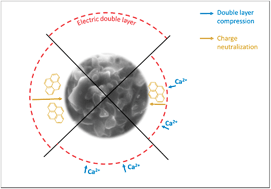Biochar particle aggregation in soil pore water: the influence of ionic strength and interactions with pyrene†
Abstract
The beneficial properties of biochar have led to its increasing application to soils for environmental management. Despite its stability in soil, biochar can physically disintegrate into smaller particles, which can then be relocated from the application area. Biochar transport is strongly dependent on the biochar particle size and aggregation, with the extent of aggregation depending on the chemistry of the soil pore water. Biochar has a strong sorption affinity for polyaromatic hydrocarbons (PAHs) such as pyrene, which can also affect its transport. We therefore investigated biochar particle aggregation in solutions of different ionic strengths (ultrapure water, 0.01 M CaCl2, and 0.1 M CaCl2) with suspensions of biochar particles, and with suspensions of biochar particles loaded with pyrene (0.2 and 3.6 g kg−1). Increasing the pyrene concentration in ultrapure water resulted in an increase in the biochar particle size, an effect that was more pronounced following equilibration for 28 days than following equilibration for only 24 hours. Biochar particle aggregation in solutions containing both pyrene and 0.01 M CaCl2 was greatly enhanced compared to aggregation in similar solutions with no pyrene. However, the influence of pyrene became negligible at high CaCl2 concentrations (0.1 M CaCl2). To determine the fate of biochar in soil, both the presence of PAHs and the influence of the pore water's ionic strength therefore need to be taken into account.



 Please wait while we load your content...
Please wait while we load your content...